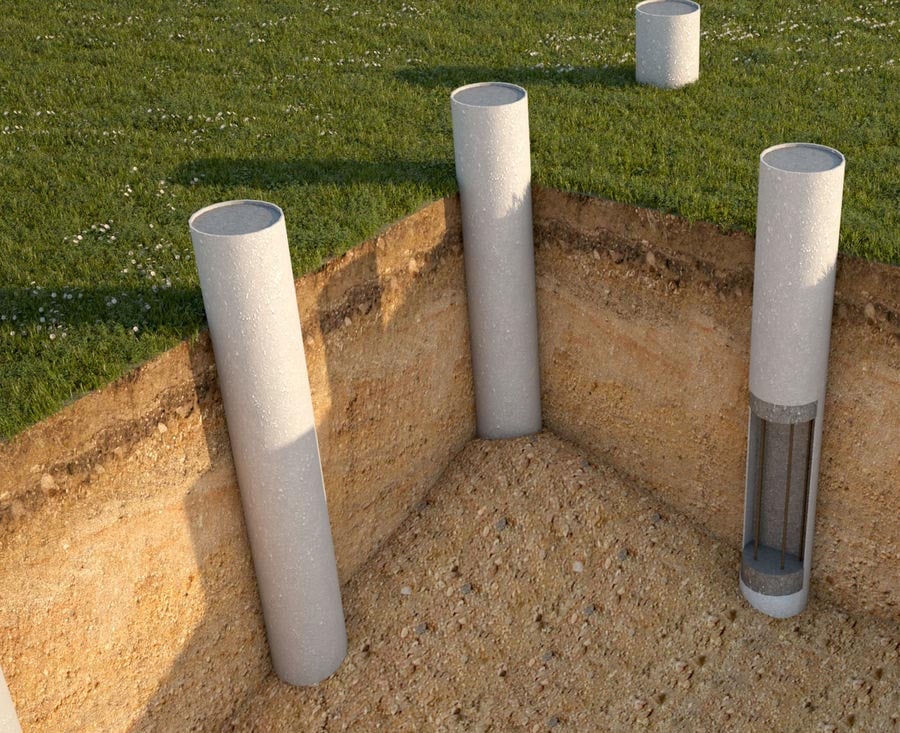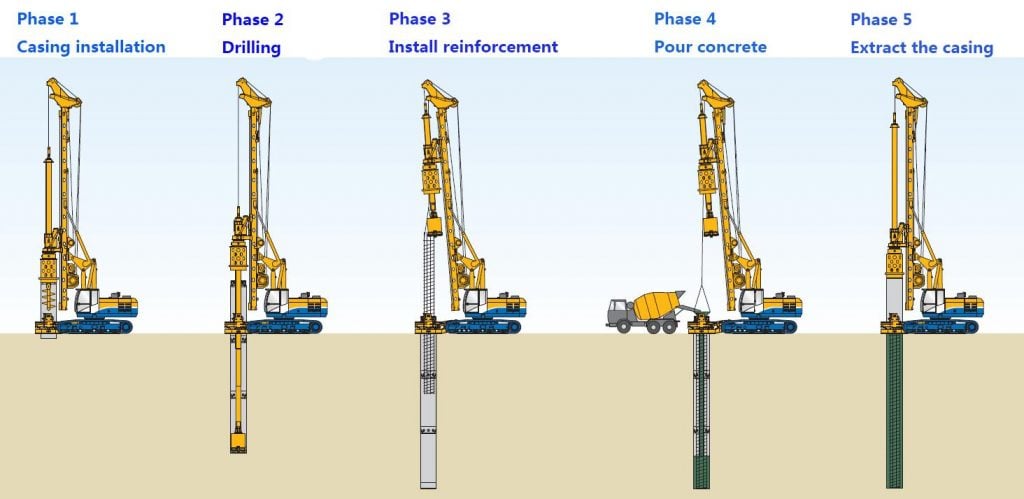Pile Foundation is the key to any architecture. It provides adequate support to the structure by transferring the loads from the structure to the soil. The important thing to consider is the fact that the layer at which the foundation puts on the load should have adequate bearing capacity and appropriate settlement characteristics.
There are mainly two types of foundations: shallow foundations and deep foundations. Shallow foundations are effective when the soil has an adequate bearing capacity to take the loads put in by the structure. Whereas deep foundation is highly effective when the bearing capacity of the surface soil is not able to carry loads put in by the structure. In such a scenario, the loads need to be shift at a deeper level where the soil can bear the excess load of the structure.

Select the type of foundation on the basis of the following criteria:
- Soil conditions;
- Cost;
- Time-frame of the project;
- Water level;
- Total load from the superstructure;
- Available resources;
- Noise and vibrations sensitivity.
Now, that you have got a basic overview of the foundations it is time to divert our attention to the pile foundation. In the forthcoming sections of this write-up, we have provide comprehensive information pertaining to the pile foundation. We promise after reading this content piece you will have all your basics cover as far as pile foundation is concern.
Let’s start with the definition of pile foundation.
Pile foundation, a type of deep foundation comes in the form of a slender column or long cylinder. It is made up of materials like steel or concrete which are employ to support the structure. It is then use to shift the load at the desire depth through skin fraction or end bearing. If a foundation has a depth which is more than thrice its breadth it is call “Pile”. These types of deep foundations are usually employ for large structures. They also come in handy where the soil at shallow depth is unsuitable to resist uplift or excessive settlement.

Now, that you have understood the definition of pile foundation, the next topic that needs to be look at are the situations where the pile foundation system is highly recommend.
When to Use Pile Foundation?
- When you find that the groundwater table is quite high;
- When heavy and non uniform loads from the superstructure are employ;
- It is not feasible to use other types of foundation either due to cost or non-feasibility;
- When the soil at shallow depth is compressible;
- When there is a possibility of cleaning, as a result of the location being near to river bed or seashore;
- The presence of canal or deep drainage systems near the structure;
- When it is not possible to conduct soil excavation at desire depth due to lack of good soil condition;
- When it becomes impossible to keep the foundation trenches dry due to heavy inflow of seepage.
Types of pile foundation.
Pile foundation can be divide into several parts on the basis of function, materials, and pile installation process.
Let us look at each of them.
Based on Function or Use
- End-Bearing Piles
- Friction Piles
- Tension or Uplift Piles
- Compaction Piles
- Anchor Piles
- Fender Piles
- Sheet Piles
- Batter Piles
- Laterally Load Piles
Based on Materials and Construction Method
- Timber Piles
- Concrete Piles
- Steel Piles
- Composite Piles
Based on Installation
- Driven Piles
- Cast in-situ Piles
- Driven and cast-in-situ Piles
Let’s look at each of these types of pile foundation in details.
Classification of the pile on the basis of function or action
End-Bearing Piles
In this pile type, the load is shift from the tip of the pile to an appropriate bearing spectrum.
Friction Piles
In this type of pile, the load is shift from a deep level through skin fraction couple with the surface area of the pile.
Tension or Uplift Piles
This type of pile foundation is highly effective when employ to uplift anchor structures as a result of hydrostatic pressure or overturning moment as a result of horizontal forces.
Compaction Piles
This type of pile foundation is quite effective when it comes to loosening granular soils to increase the bearing capacity of the soil. A sand pile is quite effective to serve this purpose as it does not require to carry any load.
Anchor Piles
These types of piles are recommend to provide anchorage to protect against the horizontal pull.
Sheet Piles
These types of piles are employ to uplift the hydraulic structures which come handy to reduce seepage.
Batter Piles
These types of piles are useful when it comes to avoiding horizontal and incline forces that come in waterfront structures.
Laterally Loaded Piles
These types of piles are extremely useful when it comes to supporting walls, bridges, and dams. They are also effective when use as fenders in docks and harbours.
Types of Piles Based on Composition and Material
Timber Piles
These types of piles are highly effective when employ in completely dry condition or submerge condition.
Steel Piles
These types of piles come in the form of pipe piles, sheet piles, and H-piles.
Concrete Piles
These types of piles come in the form of precast or cast-in-situ. It has been observe that precast piles are reinforce by nature. While installation of cast-in-situ piles is done through pre-excavation. There are different types of cast-in-situ piles: MacArthur pile, Franki pile, and Raymond pile.
Composite Piles
These types of piles are highly effective when a certain section of the pile is immerse under water. It comes in the form of concrete and timber or concrete and steel.
Types of Piles on the Basis of Installation
Driven Piles
This type of pile is use by driving timber, concrete or steel piles into position by employing the pile-driving instrument.
Cast-in-situ Piles
These types of piles employ only concrete piles. While in usage, the piles are drill and pack with concrete. It is possible to add reinforcements as per the requirements.
Driven and cast-in-situ Piles
This is the perfect amalgamation of driven and cast-in-situ piles. It employs casing or shell. One type of pile that is mostly use is Franki pile which is a part of driven and cast-in-situ piles.
Now, that you have look at the different types of pile foundation let’s divert our attention to the advantages of pile foundation.
- Possibility of precast according to specifications
- Can be pre-made into any shape, size, and length which reduces the overall completion time;
- Gives a neat and clean presentation thus requiring minimal supervision and less storage space;
- Can be employ in spaces where drilling of holes is not allow thanks to its ability to borrow and find pressurize underground water tables.
Great option while working over water as it can be highly effective in wharf structures and piles in jetties.
Let’s now dig deep into pile foundation and answer some questions that you might have pertaining to this subject.
What is the need for pile foundation?
Pile foundations are in high demand when it comes to transferring the loads from superstructures from weak foundation to a more strong and less compressible stiffer soil. This way it withstands all the horizontal loads and enhances the effectiveness of the foundation.
What are the situations when the pile foundation is highly effective?
Pile foundations can be extremely effective when there is a weak soil layer at the surface. Reason? The layer will not be able to support the weight of the building. When loads of the buildings pass the pile foundations it is shift to a stronger pile of rock that is just underneath the weak layer.
How deep should be the footings?
It has been observe that the depth of the footings should have a minimum depth of 12 inches below the past undisturb soil. As far as the footings are concern, they should be a minimum of 12 inches underneath the frost line or must be protect from frost. The width of the footings needs to be at least 12 inches.
What are the top three strongest foundations of the house?
The top three strongest foundations of the house are:
- Slab Foundations
- Crawlspace Foundations
- Basement Foundations
What depth should be considered while building foundations?
If you are near bedrock or need reinforcement with steel it is important to dig deep foundations. Commence any type of foundation by digging footings that are a minimum of 2 feet wide and as deep as the frost line. There will be certain foundations that might need an additional width, some of a maximum 6 feet wide.
Final Words
We have provide a comprehensive overview of pile foundation in this write-up. After reading this write-up, we hope you will be able to understand the subject matter in hand more appropriately. Follow the guidelines given in this content piece and you will be in a far better position while implementing pile foundation for your building construction. We hope that the information furnish in this blog will guide to take the right decisions when it comes to constructing a building. So, what are you waiting for? Start implementing the tips given in this content piece. For more such interesting information, keep following our blogs.
Read more:-

